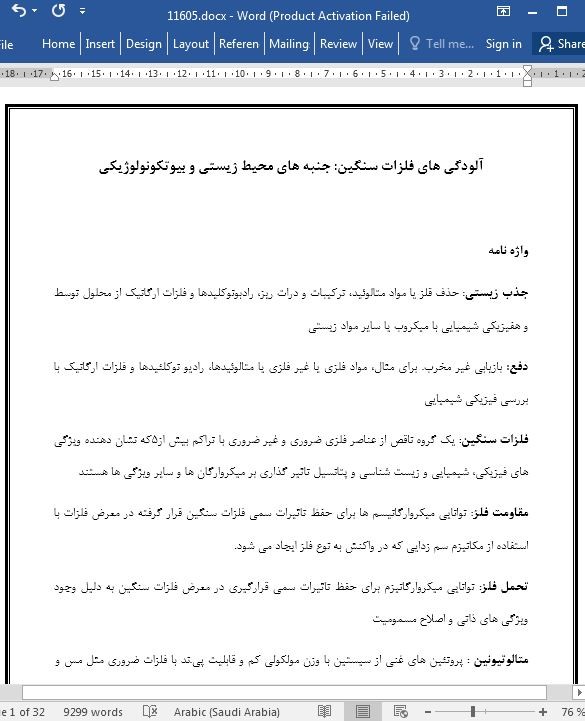
آلودگی های فلزات سنگین: جنبه های محیط زیستی و بیوتکونولوژیکی
واژه نامه
جذب زیستی: حذف قلز یا مواد متالوئید، ترکیبات و درات ریز، رادبونوکلیدها و فلزات ارگانیک از محلول توسط و هفیزیکی شیمیایی با میکروب یا سایر مواد زیستی
دفع: بازیابی غیر مخرب. برای مثال، مواد فلزی یا غیر فلزی یا متالوئیدها، رادیو نوکلئیدها و فلزات ارگانیک با بررسی فیزیکی شیمیایی
فلزات سنگین: یک گروه ناقص از عناصر فلزی ضروری و غیر ضروری با تراکم بیش از5که نشان دهنده ویژگی های فیزیکی، شیمیایی و زیست شناسی و پتانسیل تاثیر گذاری بر میکروارگان ها و سایر ویژگی ها هستند
مقاومت فلز: توانایی میکروارگانیسم ها برای حفظ تاثیرات سمی فلزات سنگین قرار گرفته در معرض فلزات با استفاده از مکانیزم سم زدایی که در واکنش به نوع فلز ایجاد می شود.
تحمل فلز: توانایی میکروارگانیزم برای حفظ تاثیرات سمی قرارگیری در معرض فلزات سنگین به دلیل وجود ویژگی های ذاتی و اصلاح مسمومیت
متالوتیونین : پروتئین های غنی از سیستین با وزن مولکولی کم و قابلیت پی.ند با فلزات ضروری مثل مس و روی و فلزات غیر لازم مثن کادیم
ترکیب فلز ارگانیک : ترکیبی که دارای حداقل یک پیوند فلز با کربن است و سمی بودن میکروبی را نشان می دهد. وقتی که این گونه ترکیبات دارای عنصر متالوئید مثل (Ge, As, Se, Teباشند واژه ارگانومتالوئید استفاده می شود.
فیتو چیلاتین: پپتیدهای Glu-Cysدارای پیوند فلز با فرمول ϒ -Glu-Cys)n-Glyکه اکنون به عنوان متالوتیونین 2 تا 7 نامگذاری می شوند و غیر متقارن هستند و دارای پلی پپتیدهای ترکیب شده با متال هستند. پیوندهای کادیم حاصل از مخمرها نیز کادیستین نامیده می شود.
سیدروفرها: ترکیبات کم وزن آهن 3 که توسط میکروارگانها تحت تاثیر قرار می گیرند و تراکم آهن از محیط های بیرونی را فراهم می سازد.
تعریف مساله
این مقاله به نقش میکروارگانیسم ها در تغییرات فلزات سنگین، متالوئیدها، فلزات آلی و رادیونوکلئیدها میان فازهای محلول و غیرمحلول می پردازد و همچنین به اهمیت محیط زیستی و بیوتکنولوژیکی این فرایندهای تغییر در چرخه های بیوژئوشیمیایی و در روش های بیوتکنولوژی برای مهار آلودگی های فلزی، متالوئیدی و رادیونوکلئیدی می پردازد.
Glossary
biosorption The removal of metal or metalloid species, compounds and particulates, radionuclides, and organometal(loid) compounds from solution by physicochemical interactions with microbial or other biological materials.
desorption Nondestructive elution and recovery of, for example, metal or metalloid species, radionuclides, and organometal(loid) compounds from loaded biological material by physicochemical treatment(s).
heavy metals An ill-defined group of biologically essential and inessential metallic elements, generally of density >5, exhibiting diverse physical, chemical, and biological properties with the potential to exert toxic effects on microorganisms and other life forms.
metal resistance The ability of a microorganism to survive the toxic effects of heavy metal exposure by means of a detoxification mechanism, usually produced in response to the metal species concerned.
metal tolerance The ability of a microorganism to survive the toxic effects of heavy metal exposure because of intrinsic properties and/or environmental modification of toxicity.
metallothioneins Low-molecular-weight cysteine-rich proteins capable of binding essential metals (e.g., Cu and Zn) as well as inessential metals (e.g., Cd).
organometallic compound A compound containing at least one metal–carbon bond, often exhibiting enhanced microbial toxicity. When such compounds contain ‘metalloid’ elements (e.g., Ge, As, Se, and Te), the term ‘organometalloid’ may be used.
phytochelatins Metal-binding -Glu-Cys peptides of general formula (-Glu-Cys)n-Gly (n generally 2–7); now designated as class III metallothioneins that are atypical, nontranslationally synthesized metal thiolate polypeptides. Cd-binding -Glu-Cys peptides from some yeasts are also called cadystins.
siderophores Low-molecular-weight Fe(III) coordination compounds excreted by microorganisms, which enable the accumulation of iron from the external environment.
Defining Statement
This article describes the roles of microorganisms in the transformation of heavy metals, as well as metalloids, organometals, and radionuclides, between soluble and insoluble phases, and the environmental and biotechnological importance of these transformation processes in biogeochemical cycles and in new biotechnologies for the treatment of metal, metalloid, and radionuclide pollution.
واژه نامه
تعریف مساله
مقدمه
جنبه های زیست محیطی آلودگی فلزات سنگین
فلزات سنگین در محیط زیست
تاثیرات فلزات سنگین بر روی آلودگی های میکروبی
اصلاح محیط زیستی مسمومیت فلزات سنگین
مکانیزم های دفع مسمومیت فلزات سنگین میکروبی
جنبه های زیست فناوری آلودگی فلزات سنگین
قابلیت حل فلز
رسوب گیری (اوتوتراپی) شمولیتوتراپی
رسوب (هتروتراپی )
تحرک زدایی فلز
جذب زیستی
جذب زیستی توسط دیواره های سلول و مواد مرتبط
جذب زیستی توسط مواد زیستی آزاد و غیر متحرک
دفع فلز
پروتئین های دارای پیوند با فلزات – پلی ساکاریدها و سایر مولکول های زیستی
انتقال و انباشتگی
رسوب فلز
رسوب توسط فرآیندهای ردوکس: باکتری های کاهنده فلز و اکسید کننده های آهن
باکتری های کاهنده سولفات
فرآیندهایی که از رسوب سولفید فلز استفاده می کند
رسوب فسفات تحت تاثیر فلز
تفکیک مغناطیسی با شیب بالا
فلز، متالوئید و فلزات ارگانیک
انتقالات
کاهش میکروبی و اکسیداسیون اوکسیانیون های متالوئیدی
متیلاسیون متالوئیدها
انتقال متالوئید میکروبی و اصلاح زیستی
جیوه و فلزات ارگانیک
نکات جمع بندی
منابع
Glossary
Defining Statement
Introduction
Environmental Aspects of Heavy Metal Pollution
Heavy Metals in the Environment
Effects of Heavy Metals on Microbial Populations
Environmental Modification of Heavy Metal Toxicity
Mechanisms of Microbial Heavy Metal Detoxification
Biotechnological Aspects of Heavy Metal Pollution
Microbial Processes for Metal Removal and Recovery
Metal Solubilization
Chemolithotrophic (autotrophic) leaching
Chemoorganotrophic (heterotrophic) leaching
Metal Immobilization
Biosorption
Biosorption by cell walls and associated components
Biosorption by free and immobilized biomass
Metal desorption
Metal-binding proteins, polysaccharides, and other biomolecules
Transport and accumulation
Metal precipitation
Precipitation by redox processes: metal-reducing bacteria and iron oxidizers
Sulfate-reducing bacteria
Processes utilizing metal sulfide precipitation
Phosphatase-mediated metal precipitation
High-gradient magnetic separation
Metal, Metalloid, and Organometal Transformations
Microbial reduction and oxidation of metalloid oxyanions
Methylation of metalloids
Microbial metalloid transformations and bioremediation
Mercury and organometals
Concluding Remarks
Further Reading
- اصل مقاله انگلیسی با فرمت ورد (word) با قابلیت ویرایش
- ترجمه فارسی مقاله با فرمت ورد (word) با قابلیت ویرایش، بدون آرم سایت ای ترجمه
- ترجمه فارسی مقاله با فرمت pdf، بدون آرم سایت ای ترجمه


